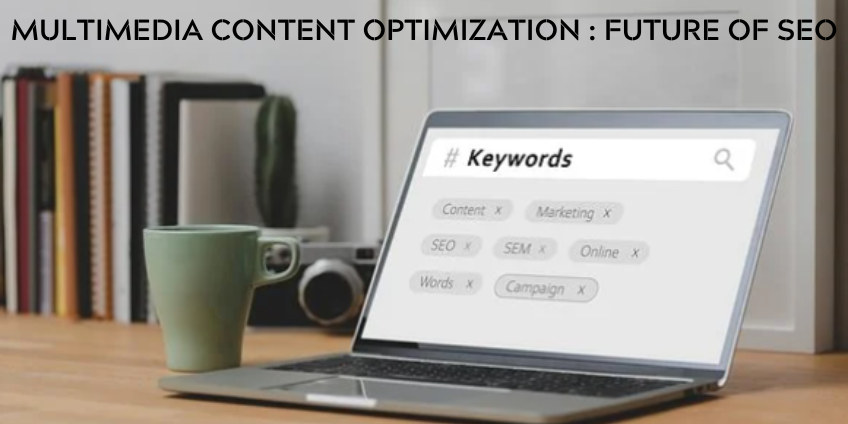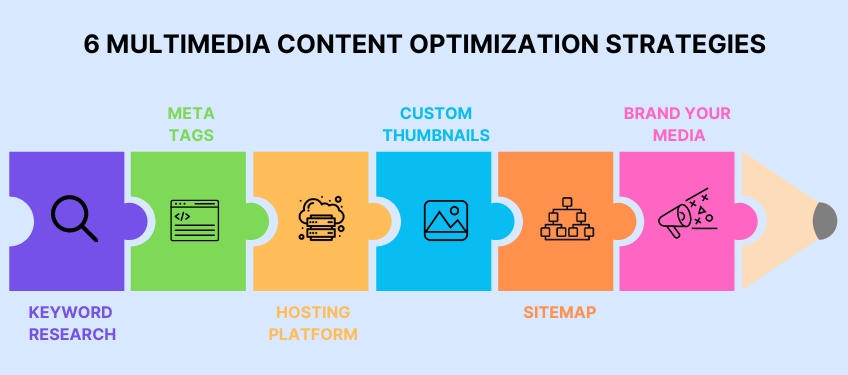Multimedia Content Optimization Strategies
The process of ensuring that content is written to reach the broadest possible target audience is known as content optimization. Making sure associated keywords are present, adding meta and title tags, and relevant links should all be part of the content optimization process.
It is critical because it ensures that search engines and users can easily understand your content. The advantages of content optimization include high-quality, search engine-friendly content that is simple to use and find.
Multimedia content such as Audio and video has grown in popularity over the last decade People nowadays don't just use Google search. They're also making use of the search bar on Spotify and YouTube. If your content appears in these search results, it has enormous potential. Consumption of multimedia content is increasing.
Let’s discuss the types of Multimedia:

1. Images and Infographics
Images are perhaps the simplest type of multimedia content that you can create with a smartphone. You can create many pictures and add them to your website and social media profile. An optimized image can convert very well, and it is well known that ranking high on an image search is much easier than ranking high on a universal search. A picture can be optimized simply by adding an alt attribute with the corresponding keyword for that image. Infographics have grown in popularity in recent years because they are simple to read and understand. It is a summary of an article.
2. Audio Content
Although it is not as popular as the previous two, audio media content can add value to your website. Audio content, like video content, can be created and shared on social media channels similarly.
3. Video
It is the most crucial type of content you can create. A video has many advantages, including being engaging and straightforward to watch in terms of multimedia videos that will become more popular. Benefits of Video Marketing include videos that can be shared on various social media profiles and go viral.
4. Mobile Apps
Smartphones have made mobile apps increasingly popular among digital users. Mobile apps are distributed through two digital platforms: Apps Store and Google Play, which operate on two different operating systems: iOS for Apple and Android for Google. Should we consider mobile app development to be part of SEO? The answer is "Yes." SEO for Apps, also known as ASO, is not a new concept. Many apps still rely on pay-per-click to gain online visibility. App store optimization and SEO can coexist.
5. VR (Virtual Reality)
Virtual reality (VR), or the ability to simulate experiences that are similar or completely different from the real world, will undoubtedly have a significant impact shortly. Virtual reality systems are controlled by headsets that can simulate real-world objects, sounds, and sensations, thereby improving user experience.
VR technology is widely used and thriving in the video game industry, but it can also be used in corporate training. The next question is whether this content can be optimized for universal search results. VR applications, like mobile apps, can be imported from specialized sites such as "Oculus." Scripts, graphics, and CPU performance can all be improved for a better user experience.
Now that we have covered the types of multimedias in the market, lets understand how we can optimize the content we produce for our clients
6 Valuable and Practical Multimedia content optimization strategies
Content marketing optimization is critical because your audience is unlikely to find your content without it. Content optimization works by changing your content's copy, structure, and metadata so that search engines receive strong signals that it is functional. When it comes to optimizing your content, there are several factors to consider:

1. Keyword Research It is the most crucial aspect of SEO. Going after popular keywords is every SEO professional's dream, but this strategy can be extremely tricky; competition can be fierce for popular keywords, and it is not a wise strategy. Ranking for competitive keywords is also possible, but it will take some effort. Long-tail keywords are an effective strategy. There are numerous keyword research tools available, but free tools such as Google Keyword Planner and Google Trends are in this article.
Why should someone use Google products? They are free; you do not need to pay a monthly subscription fee. Google Trends is an excellent and simple tool for analyzing different search terms over different periods, as shown in the image. This tool is fantastic for multimedia optimization because it allows you to see other trends such as Youtube search, Image search, and Google shopping.
2. Meta Tags It would be best to use the title and description tags to enhance search engine value for optimizing your multimedia content, such as: (video, images, and apps). It is common knowledge that content with an engaging title tag converts better along with content with appropriate description.
Here are some pointers on how to improve your title:- Your title should accurately represent your content.
- Don't forget to include your main keyword, which represents the content.
- Regularly update your content.
A compelling narrative can aid conversion. Remember that using too many keywords can lead to keyword stuffing, which are strategically incorrect for ranking. Here are amazing tips for a compelling and attractive description
Tips for improving your description:- Make an effort to accurately describe your media content (video, image, apps).
- Encourage viewers to subscribe to your channel (YouTube, website, and app)
- Connect your content to other media channels.
- Incorporate keywords from your title tag into the video tag.
3. Hosting Platform Multimedia content may be hosted on a variety of platforms, depending on the type of content and the key objectives. Goals might vary from company to company. Some companies attempt to increase the number of website visits, while others seek to enhance lead generation.
Your website is the ideal place for photos and graphics, but social media sites may be used effectively for other channels and YouTube and Vimeo are the greatest video sites available. Two digital platforms allow for the creation and distribution of content for mobile applications: the App Store and Google Play.
Virtual reality or VR technology may be transferred into game-centric platforms such as Oculus and PlayStation.
4. Custom thumbnails Custom thumbnails, which are more common in videos, are images that appear in various shapes and sizes. Photos or thumbnails that make your content more compelling, relevant, and beautiful are one of the reasons why some videos on YouTube convert well while others do not.
Tips for creating custom thumbnails:- Combine colors, images, and shapes that are representative of your brand
- Clear and high-resolution images.
- Ensure that your thumbnails are device responsive
5. Sitemap A sitemap is a simple way for search engines to discover your website and automatically index certain types of content, such as images and videos. A video sitemap informs Google about your videos. You can easily add a sitemap to your website by visiting XML Sitemap Generator. Creating an image or video sitemap can tell Google about your content and increase your chances of appearing in the universal search results.
6. Brand your media Many practitioners of SEO Marketing Agency will tell you that your content should be created and optimized for search engines, which is partially correct. It is clear what Google's policy is regarding the criteria for ranking websites, with priority given to brands.
Creating a brand is a time-consuming and challenging process. A logo is always the first step in the branding process. Make sure to include your logo in any content you create, such as images and videos. If you use a YouTube video channel, brand it with your logo and website URL.
Strike a Balance Between SEO and PPC
SEO has numerous advantages over other types of marketing. Relying solely on SEO is risky and complex. Because search engines' algorithms change regularly, you can't be sure that what you do today will be available tomorrow—a viable substitute for pay-per-click. Pay-per-click campaigns can quickly get results for media content such as images, video, apps, and VR. Google ads are perhaps the most popular advertising strategy for any lead in your buyer funnel; You can run various types of ads such as: search, video, and shopping for driving awareness, converting customers, or for even getting store visits. Social media platforms (Facebook, Instagram, and Linkedin) have huge popularity of audiences of all age groups and interest, anyone looking to generate awareness or interest among their audience or even retain clients can opt for any of these platforms. It is critical to remember what Google stated in the statement: "Content should be created for users, not search engines." Follow a systemic approach and set actionable goals, and you will be ahead of the game.
Need help in creating an effective content marketing strategy customized for your business? Scorich, the leading content marketing agency in Gurgaon, works with you to maximize the effectiveness of your content. We create a comprehensive content strategy for our clients after thoroughly understanding their market position, marketing objectives, and competitor analysis.
You can engage your audience and increase revenue with our carefully curated content strategies. Contact us if you want to create quality content and build your brand!
